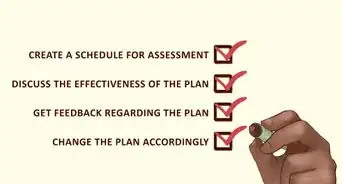This article was co-authored by Helena Ronis. Helena Ronis is Co-founder and CEO of AllFactors, a unified web analytics software to drive company's marketing and business growth. She has worked in product and marketing in the tech industry for over 8 years, and studied Digital Marketing & Analytics at the MIT Sloan School of Management Executive Program.
There are 13 references cited in this article, which can be found at the bottom of the page.
wikiHow marks an article as reader-approved once it receives enough positive feedback. In this case, 83% of readers who voted found the article helpful, earning it our reader-approved status.
This article has been viewed 354,095 times.
A business plan can only be complete it if includes a market analysis, which identifies the target market and provides information about competitors. The market analysis is very important to anybody looking to start or continue their work at a business because it provides necessary information about customers and the competition, two things every businessperson must think about. The process of writing one will also give you insight into how markets operate and how your business can thrive in one. To write a proper market analysis, you will need to do extensive research and work on gathering data, analyzing it, and presenting it in an effective manner.
Steps
Conducting Market Research
-
1Assess what information you don’t know. Market research is all about finding information that will help you effectively market your business. Sit down and write out what you don’t know about your potential customer base. Consider the following:[1]
- Size of your market. For example, you might want to start a business that caters to children. Do you know how many people within a 20-mile radius have children? These people are most likely your potential customers.
- Media habits. Do you know what publications or media your customers use? If you want to use paid promotions, then you’ll need this information.
- Income. Do you know how much income your target consumers have? This information will impact how much you can charge and whether your business will be profitable.
EXPERT TIPHelena Ronis is Co-founder and CEO of AllFactors, a unified web analytics software to drive company's marketing and business growth. She has worked in product and marketing in the tech industry for over 8 years, and studied Digital Marketing & Analytics at the MIT Sloan School of Management Executive Program.Business Advisor
 Helena Ronis
Helena Ronis
Business AdvisorHelena Ronis, startup founder and CEO, tells us: "There are really two market analyses to do — the general analysis of the money in the market and then the product analysis: You want to ask does this product exist, and if it does, how well does it solve the problem? Is there room for something better?"
-
2Use publicly available information. You might want to know the number of homes in a given area, or the number of people who live within a city. This information should be publicly available. For example, the U.S. Census Bureau compiles data by zip code.[2]Advertisement
-
3Pull information from social media. If you have a social media presence already, you can pull demographic statistics. Look at who is following you and note their age, gender, and location.[3]
-
4Contact industry associations. You’ll need basic information about your market, e.g., its size and current trends. You might contact an industry association for information on the current state of the industry. You can also look online. Often, associations publish surveys or other research.
-
5Survey your current customers. Your current market isn’t necessarily your target market. For example, you might only be mowing lawns locally but hope to develop a regional landscaping business. Nevertheless, you can find out important information from your current customers. If you have their email addresses, you can ask them to fill out an online survey. You can also put the survey on any printed receipt that you give customers.
- Ask current customers why they do business with you.[4] Do they buy because of price, convenience, quality, etc.?
- Ask if they see your promotional efforts. Ask how they learned about your business.
-
6Hire someone to perform market research. You might not know where to begin or can’t find relevant information after diligent searching. Consider hiring someone to perform market research. This person can track down statistics and perform consumer surveys.
- To save money, you can hire an independent market research consultant instead of a full-fledged market research firm. Consultants charge $75-150 an hour and they can organize focus groups or construct a mail or phone survey.[5]
- You might also talk to a local marketing professor. Business schools often conduct real-world market research, and a professor might be willing to help you for free.
-
7Study your competitors. Each market analysis contains a competitive analysis. In particular, you should look at your competition and identify their strengths and weaknesses.[6] It’s pretty easy to scope out your competitors. Stop in and do business with them.
- Read online reviews to get a sense of how the public views your competitors. Take complaints with a grain of salt, but look for patterns. For example, consistent complaints about price reveals a real problem.
Drafting Your Market Analysis
-
1Identify your audience. A market analysis can be complex or simple. Tailor it to your audience. For example, if you are seeking investors, then they will need more detail than if the business plan is solely for internal use—however, don’t overdo it.[7]
-
2Define your target consumers. Include demographic information such as their age, income, location, gender, etc. Also describe their buying habits and hobbies.[8]
- For example, if you are running a children’s clothing boutique, then your target consumer might be stay-at-home moms who are middle class.
- Many businesses target multiple market segments. For example, a coffee shop might target people who work within a five mile radius as well as teens and the elderly who drink coffee.[9] However, be realistic when identifying your market segments. Not everyone in the world is a potential customer.
-
3Explain what market need you satisfy. Your products or services should meet a consumer need.[10] For example, a children’s clothing boutique meets the needs of parents who want to dress their children in unique outfits. Sometimes, a need only arises after you’ve created your business. However, it will be difficult to get investors in this situation.
- For example, you might describe the need for children’s clothing this way: “Increasingly, young parents want to establish their children’s individual identify from an early age. Just as clothes make the person, a child’s clothing plays a key part in how others perceive them—and their parents. The unique outfits at Kid’s Couture LLC will let status-conscious parents nurture their child’s individuality.”
-
4Analyze the industry. Offer a birds-eye view of your industry. How fast has the market grown? What is its current size? Provide national and local information. Give the reader some sense of whether this is an emerging market or one that is established.
- For example, an analysis of the coffee industry might begin, “Coffee consumption in the U.S. has grown at a 2.5% annual growth rate for the past 10 years. The retail coffee industry has grown at twice this speed in northern New England….”[11]
-
5Identify market trends. Markets rarely stand still. You should note any changes that you see. What are the changes in demographics, taste, or customer needs?[12] Are certain products or services gaining traction.
- For example, young families might be moving into an area. By contrast, a neighbor may be aging as few young people move to it. These trends can affect the success of your business.
-
6Provide a competitive analysis. Identify your competitors’ market share and then discuss their strengths and weaknesses. Also explain how you will take advantage of current competitor weaknesses. Usually, you will offer a service that your competitors don’t, but you might also provide a different experience.
- For example, a children’s boutique might find that there is no one within driving distance who offers original children’s clothing. Instead, the only competitors might be box stores who offer popular brands.
- A coffee shop might compete by offering a comfortable, at-home atmosphere that brand stores cannot create.[13]
-
7Draft a short summary of the market analysis. You should write the summary last but put it at the front of the market analysis. Provide a capsule summary of the highlights. Generally, the summary can be as short as one paragraph.
- This summary might be included in a loan application, so it should be as thorough as possible while maintaining brevity.[14]
-
8Adjust the other sections of your business plan. Based on your research and analysis, you might need to change other parts of your business plan. This is not unusual—your initial assumptions might have been wrong. For example, you might need to change your marketing plan based on what you learned about consumer behavior. If your target market doesn’t watch television, there’s no reason to pay for pricey TV ads.
- If the demographics of a neighborhood are changing in a way that’s bad for your business, you might need to relocate.
- If your target market has less disposable income than anticipated, you will need to change your pricing strategy.
Polishing Your Market Analysis
-
1Use graphics to make information vivid. It can get boring reading block paragraphs. If possible, present market analysis information using graphs, pie charts, and other visuals.[15] They will break up big chunks of text and make the information easier to digest.
-
2Ask a business associate to read your analysis. A fresh set of eyes might find errors or omissions. For example, you might not have identified your target market clearly enough. Another business owner who has written a market analysis can see areas where it should be strengthened.
-
3Get help from a business mentor. In the U.S., you can stop into a Small Business Development Center (SBDC) and get help drafting your business plan. Find the nearest SBDC at https://www.sba.gov/tools/local-assistance/sbdc. Make an appointment to talk about your market analysis.
-
4Proofread your market analysis. Presentation matters. You’ll lose potential investors if you have errors, such as typos or grammatical mistakes. Also pay attention to numbers and make sure that you haven’t misplaced a decimal or comma.
- Set your marketing analysis aside for some time so that you will come back to it with fresh eyes.[16] If possible, set it aside for a few days.
- Proofread from a paper print-out and not on the computer screen.
References
- ↑ https://www.forbes.com/sites/mikekappel/2017/01/09/find-your-customers-with-a-target-market-analysis/2/#1d601b61cd41
- ↑ https://www.forbes.com/sites/mikekappel/2017/01/09/find-your-customers-with-a-target-market-analysis/2/#1d601b61cd41
- ↑ https://www.forbes.com/sites/mikekappel/2017/01/09/find-your-customers-with-a-target-market-analysis/2/#4166fcfacd41
- ↑ https://www.forbes.com/sites/mikekappel/2017/01/09/find-your-customers-with-a-target-market-analysis/2/#1d601b61cd41
- ↑ https://www.inc.com/articles/2001/05/22722.html
- ↑ http://articles.bplans.com/how-to-write-a-market-analysis/
- ↑ https://www.inc.com/articles/1999/12/15964.html
- ↑ http://articles.bplans.com/how-to-write-a-market-analysis/
- ↑ http://www.bplans.com/coffee_shop_business_plan/market_analysis_summary_fc.php
- ↑ https://www.inc.com/articles/1999/12/15964.html
- ↑ http://www.bplans.com/coffee_shop_business_plan/market_analysis_summary_fc.php
- ↑ https://www.inc.com/articles/1999/12/15964.html
- ↑ http://www.bplans.com/coffee_shop_business_plan/market_analysis_summary_fc.php
- ↑ https://www.inc.com/articles/1999/12/15964.html
- ↑ https://www.scu.edu/mobi/business-courses/starting-a-business/session-2-the-business-plan/
- ↑ https://writing.wisc.edu/Handbook/Proofreading.html
- ↑ https://www.entrepreneur.com/article/78002#
About This Article
To write a market analysis, use short paragraphs and include charts and graphs of your data. You should craft a summary of what your company will add to the marketplace and put it at the beginning of your analysis. Then, explain who your target consumers are as well as how you plan to attract those customers. You'll want to include a competitive analysis that identifies competitor's strengths and weaknesses. Before you submit your analysis, get it reviewed by the Small Business Administration or a colleague for proofreading. For tips from our Editor reviewer on polishing and proofreading your analysis, keep reading.























-Step-20-Version-3.webp)




















































